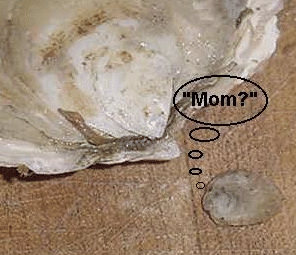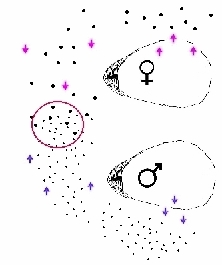Naissains
John McCabe
In France, oyster babies are collectively referred to as "naissains".
The term "naissains" is about as "scientific"
as the term "oyster babies". Depending on whom you
talk to, a "naissain" or "oyster baby" can
be the oyster larva, or the tiny brownish dot on some kind of
substrate it turns into after metamorphosis, or a tiny oyster
the size of a finger nail. Considering that oysters can reach
20 to 30  years
of age, any oyster under the age of one year is very young.
years
of age, any oyster under the age of one year is very young.
The oystermen of Arcachon likely don't
really care to argue where an oyster starts and stops being called
a "naissain". All that matters are "the dots"
- the more the merrier!
Two species of oyster live in the Arcachon
Bay, the Pacific oyster and the European oyster. The Pacific
oyster is by far the commercially more important species. Sometime
in March or early April, when the water reaches a temperature
of about 13° C, the Pacific oysters start getting a little
"romantic". Nature's wisdom decides how many males
and females will exist among these hermaphrodites. Sometime between
May and June, the Pacific oysters get "milky". Each
oyster is now filled either with sperm or eggs - by the millions.
In the summer months, when the water in the bay reaches about
19° to 22° C, the oysters spawn. The Arcachon Bay is
a huge and complex marine environment. The pacific oysters may
thus spawn a little earlier in one area of the bay than in another.
 Unlike European oysters, Pacific oysters don't take
care of their offspring at all. They are scientifically referred
to as "broadcast spawners". Enormous masses of sperm
and eggs are released almost simultaneously into the sea. Purely
by chance, "some" sperm will find "some"
eggs and oyster larvae will begin to form. Since we are talking
billions of sperm and eggs emitting from a bed of Pacific oysters,
"some" can easily translate into millions of Pacific
oyster larvae. However, the chance of survival of a Pacific oyster
larva is not very good. It is just slightly better than that
of a snowball in hell. After about twenty days of floundering
around in the plankton layer of Arcachon Bay, running the gauntlet
of countless natural enemies and other dangers, likely only one
percent will live long enough to find a suitable place to settle
down on and survive the radical metamorphosis into a "baby
oyster" - which soon is visible to the naked eye as a tiny
brownish "dot," no bigger than a pin head.
Unlike European oysters, Pacific oysters don't take
care of their offspring at all. They are scientifically referred
to as "broadcast spawners". Enormous masses of sperm
and eggs are released almost simultaneously into the sea. Purely
by chance, "some" sperm will find "some"
eggs and oyster larvae will begin to form. Since we are talking
billions of sperm and eggs emitting from a bed of Pacific oysters,
"some" can easily translate into millions of Pacific
oyster larvae. However, the chance of survival of a Pacific oyster
larva is not very good. It is just slightly better than that
of a snowball in hell. After about twenty days of floundering
around in the plankton layer of Arcachon Bay, running the gauntlet
of countless natural enemies and other dangers, likely only one
percent will live long enough to find a suitable place to settle
down on and survive the radical metamorphosis into a "baby
oyster" - which soon is visible to the naked eye as a tiny
brownish "dot," no bigger than a pin head.
As mentioned, ending up with as many of these "oyster dots"
is the name of the game for the oystermen of Arcachon. It's an
extremely labor intensive and very expensive "game".
Winning or loosing may mean the difference between prosperity
and poverty. It's called "Captage"!


